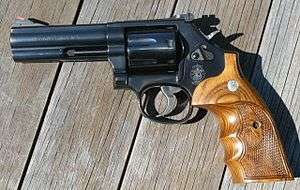Smith & Wesson Model 586
The Smith & Wesson Model 586, is a six- or seven-shot double-action revolver chambered for the .357 Magnum cartridge; it will also chamber and fire .38 Special cartridges. The Model 586 has a carbon steel construction and is available in a blued or nickel finish; it is essentially the same firearm as the Model 686, which has stainless steel construction. It is also known as the Distinguished Combat Magnum.
| Smith & Wesson Model 586 | |
|---|---|
 586-7 Revolver with 7-round capacity and factory wood grips and hammer lock | |
| Type | Revolver |
| Place of origin | United States |
| Production history | |
| Manufacturer | Smith & Wesson |
| Produced | 1981–1999, 2012–present |
| Variants | 586-(1 through 8) 686 (stainless steel) |
| Specifications | |
| Cartridge | .357 Magnum .38 Special |
| Action | Double action and single action |
| Feed system | 6-round or 7-round cylinder |
| Sights | Adjustable rear open sights |
Description
In addition to being able to chamber and fire .357 Magnum cartridges, the 586 will chamber and fire .38 Special cartridges as well as .38 Special +P (overpressure ammunition). The 586 has been available with 2½ in, 3 in, 4 in, 6 in, and 8⅜ in (64, 76, 102, 153, and 214 mm) barrel lengths as standard models and other barrel lengths either by special order from S&W's Performance Center custom shop, or acquired from or built by after-market gunsmiths.[1] The barrel has a twist rate of 1/18.75 for the 158 grain bullet.
The Model 586 uses S&W's L (medium) revolver frame, with a K-frame-sized grip mated to a larger diameter cylinder. During the 1980s, Smith & Wesson developed its L-frame line of .357 Magnums: the Model 581, Model 586, Model 681, and Model 686. The Model 581 had a fixed notch type rear sight, whereas the 586 used a target style adjustable rear sight. These handguns had a major effect on both law enforcement and sporting markets. The 586 was introduced in 1980, while the 581 was discontinued in 1988.[1]
The K-frame guns, though popular with police departments, were felt to be too light for full-power .357 ammunition, and a heavier and more durable gun was desired, in the same frame size. (This would avoid the complaints attaching to the larger, heavier N-frame Model 29 and Model 58.[2]) Designed with input from official S&W historian Roy Jinks, the L-frame was the result, and it quickly gained praise from policemen and hunters.[1]
The 586 was discontinued in 1999. After a 13-year absence, it was reintroduced in 2012 with the aforementioned safety modifications, plus an improved yoke, as the 586-8 variant.[1] These are produced with 4- and 6-inch barrel lengths, as part of Smith & Wesson's Classic line of revolvers.
Recall
For L-frame revolvers manufactured before August 1987 (seven years after the release of the Model 586), there were limited reports of cylinder binding occurring with .357 Magnum ammunition using a lighter weight bullet (versus the standard weight 158 grain bullet) and loaded to a high velocity. S&W put out a product warning and authorized a no-charge upgrade to make modifications to all 586, 586-1, 686, 686-1, and 686CS-1 revolvers.[3]
Engineering and production changes
- 586 (no dash), 1980 Introduction model
- 586-1, 1986 radius stud package, floating hand
- 586-2, 1987 changed hammer nose, bushing and associated parts
- 586-M, 1987 Product warning by S&W: M over stamped to signify a modification by factory or warranty station for 586 and 586-1
- 586-3, 1988 new yoke retention system
- 586-4, 1993 change rear sight leaf, drill and tap frame, change extractor, Hogue grips
- 586-5, 1997 delete 8 3/8" barrel/change to MIM thumbpiece/Ship with Master trigger locks
- 586-6, 1997 change frame design to eliminate cylinder stop stud, eliminate serrated tangs, MIM hammer and trigger, change to internal lock.
- 586-7, 2004 Performance Center .38 Super, 6-Shot unfluted cylinder, 4" barrel, Stainless Steel, 250 Made, seven shot with internal lock
- 586-8, 2012 Reintroduction as a Classic Series with internal lock 6-shot 4" and 6" RR, WO TS SB[4]
Recall
In 1987, seven years after the release of the Model 686, there were reports of cylinder binding with some types of standard .357 Magnum ammunition for L-frame revolvers manufactured before August 1987. S&W put out a product warning and authorized a no-charge upgrade to make modifications to the revolver. All recalled and reworked guns were stamped with an M marking, signifying that they had been recalled and fixed; thus it is known as the M modification for all 686, 686-1, 586-1, and 586-2 revolvers.[5]
References
- Standard Catalog of Smith & Wesson; 3rd Edition (Gun Digest Books, 2006)
- "Smith & Wesson's .41 Magnum", Free Patriot Web site. Accessed August 6, 2008.
- Product Warning, Popular Mechanics, January 1988, p. 11.
- Supica, Jim; Hahas, Richard (2016). Standard Catalog of Smith and Wesson (4th ed.). Iola, WI: Gun Digest. p. 298. ISBN 978-1-4402-4563-3. Retrieved 6 January 2020.
- Product Warning, Popular Mechanics, January 1988, p. 11.